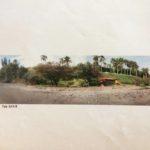Editor’s Note: This story has been updated to correct information that the source of river runoff and sediment deposit is not Wailuku River but from Honolii river itself.
Visit Honolii Beach Park these days and you might see a few more people — and a lot more sand — than usual.
Just in time for Christmas, Honolii’s typically rocky shoreline has given way to hundreds of yards of black sandy beach following heavy rainfall late last month that dumped more than 10 inches of rain over parts of East Hawaii within just a few days.
Several lifeguards on Friday said it’s the most sand they’ve seen at the popular East Hawaii surf spot since 2008. Hundreds of sunbathers, picnickers and keiki and their families have flocked to Honolii since last week to enjoy it.
“It’s so much of a different place when you have sand,” John Kapsky, longtime Honolii ocean safety officer, said Friday. “The whole beach becomes a place to come out and hang out. Last week Friday there were so many people — like 150 people — just hanging out. There were families, people making fires with driftwood and people staying all day and even staying and cooking dinner.
“It’s way appreciated and really a special treat to have this.”
“It changes the whole vibe of Honolii,” added ocean safety officer Pono Kodani. “And for the (lifeguards) also — from our perspective, we’re normally looking at rocks and surf, and now we have a beach to look at. It’s amazing, and it’s been a blessing.”
The sand is “basically runoff from the river during heavy rains a couple of weeks back,” Ryan Lyman, forecast meteorologist with the Maunakea Weather Center, said in an email Friday. Lyman said the persistence of events, which occurred several times over the course of 10 days, caused a large amount of sand to wash out and form a sandbar.
“This sandbar generally gets washed back to shore over a week or two (depending on wave size and how far out the sand went) then forms a large beach, particularly if rainfall was intense or lasted a long period,” Lyman said. “In time (in orders of months sometimes years), this beach will usually erode and retreat/return to the mouth of river by the current. Then the cycle will repeat itself with the next heavy rain event.”
Lyman said the sand runoff phenomenon occurs across most of the river breaks in East Hawaii, including in Papaikou, at Kolekole Beach Park and, to some extent, Hakalau. He said the amount and intensity of rain, along with the swell size at the time, determine how far the sand goes out to sea and/or across the bay.
Lifeguards on Friday estimated Honolii’s sandbar extended up to 400 yards at its peak last week. Even during high tide that afternoon, a scattering of sunbathers lay below Honolii’s sprawling false kamani trees, and children were frolicking along the shore, taking advantage of the smooth sandy surface.
Even surfer Jules Dudoit, a regular, said the sand was much appreciated.
“I’ve been coming here 30 years and I’ve never seen it like this,” the Orchidland resident said. “Normally, you (paddle) out and have a good time, and you come back and you might kick your toe on the rock and it hurts. That sucks. But now you can go out and surf, come back in and everything is cool. … Prayers were answered.”
“It’s pretty cool,” added Kapoho resident Jadya Gann, 18, who came to Honolii for a beach day Friday with friend Starla Brown, 17, of Mountain View. “There are not many beaches like this in East Hawaii — and usually all along this beach it’s just rocky.”
The sandbar has retreated somewhat since last week. Kapsky said based on past experience, it probably will continue to do so, though he predicts the beach will stick around in some form up to five months, contingent on “wave action.”
“If we have minimal waves, it will last longer — the bigger the waves, the faster the process happens,” Kapsky said. “And that’s the variable you can’t predict.”
Email Kirsten Johnson at kjohnson@hawaiitribune-herald.com.













